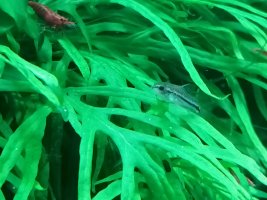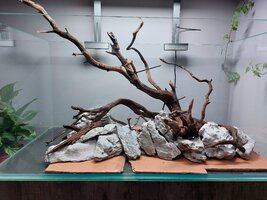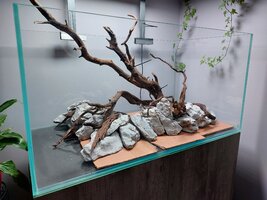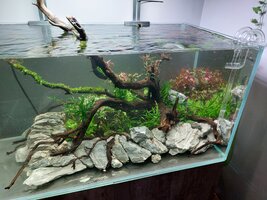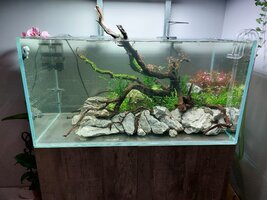-
You are viewing the forum as a Guest, please login (you can use your Facebook, Twitter, Google or Microsoft account to login) or register using this link: Log in or Sign Up
You are using an out of date browser. It may not display this or other websites correctly.
You should upgrade or use an alternative browser.
You should upgrade or use an alternative browser.
AS900- restart and rethink.
- Thread starter SRP3006
- Start date
9 months. Ticking along nicely. Soil on the sand still driving me crazy but apart from that all the plants seem to be happy. Had a little outbreak of bba on some of the buce on the left hand side. A bit of an oversight from me as direct sun was hitting the tank for 20 minutes early in the morning, only does this in May and June so made up a little screen to stop this.
Attachments
-
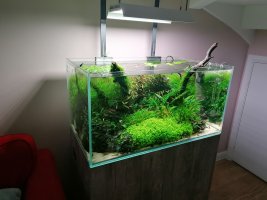 IMG_20210606_192648.jpg3 MB · Views: 280
IMG_20210606_192648.jpg3 MB · Views: 280 -
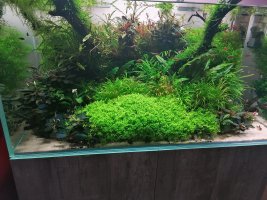 IMG_20210606_192659.jpg4.7 MB · Views: 266
IMG_20210606_192659.jpg4.7 MB · Views: 266 -
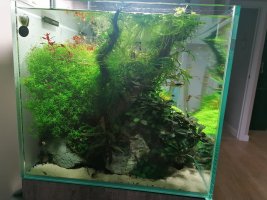 IMG_20210606_192710.jpg3.6 MB · Views: 250
IMG_20210606_192710.jpg3.6 MB · Views: 250 -
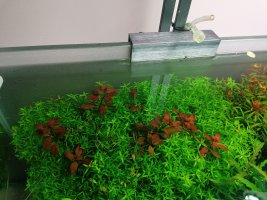 IMG_20210606_192719.jpg4.1 MB · Views: 217
IMG_20210606_192719.jpg4.1 MB · Views: 217 -
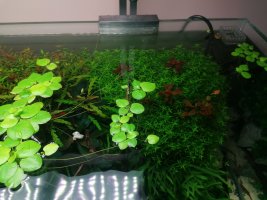 IMG_20210606_192727.jpg3.2 MB · Views: 209
IMG_20210606_192727.jpg3.2 MB · Views: 209 -
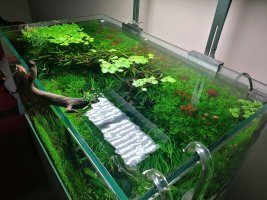 IMG_20210606_192751.jpg4 MB · Views: 226
IMG_20210606_192751.jpg4 MB · Views: 226 -
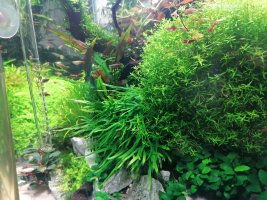 IMG_20210606_192739.jpg4.3 MB · Views: 241
IMG_20210606_192739.jpg4.3 MB · Views: 241
Had to break the tank down due to having some flooring done. This has allowed me to play about with layouts. I've missed not having the tank for the last 6 weeks or so and itching to get it up and running again.
Trying an triangle layout this time with a larger foreground sand area to the front and left, hopefully try to avoid the pain I had with losing soil on the previous scape.
Also the triangle scape will allow the wcmm's to shoal and the cories will have plenty of sand to explore, which sunlight will hit in the morning during 3 months of the year. Hopefully by planting away from where the sun will hit I can avoid algae issues?
Anyway what do you guys think of the scape?
Trying an triangle layout this time with a larger foreground sand area to the front and left, hopefully try to avoid the pain I had with losing soil on the previous scape.
Also the triangle scape will allow the wcmm's to shoal and the cories will have plenty of sand to explore, which sunlight will hit in the morning during 3 months of the year. Hopefully by planting away from where the sun will hit I can avoid algae issues?
Anyway what do you guys think of the scape?
Attachments
Nice shape!
It looks really good! Do you have another piece of wood you could add to the background? It could provide more depth . . . though your planting choices could do a lot for adding depth as well.
I'll look forward to seeing how this develops! 🙂
I'll look forward to seeing how this develops! 🙂
Thanks. The layout changed slightly due to me not being able to replicate the same scape after removing the card 🙄
I don't have another bit of wood but I think I've removed the empty space to the right by using more rocks and moving the wood slightly.
It's currently working through a dark start and I'm trying to finalise a plant list but I'll put it up on here to see any anybody sees something that could catch me out.
Bolbitus Heudelotti
Microsorum pteropus trident
Cryptocoryne willissii
Cryptocoryne lucens
Cryptocoryne petchii
Cryptocoryne albida brown
Anubias nana
Ludwigia sp mini super red
Rotala H'ra
Hemianthus micramthemoides
Limnophila hippuridoides
Bucephalandra theia and sp red to be added after a few weeks as I don't want them melting.
Unsure on the stems to be honest. Got a bit of space at the back for stems and know for sure that I want HM in there again. Not sure which others work with it. Also want something to soften the line between rock and plant, ie something like Eleocharis Acicularis or Helanthium tenellum just not had any experience in how they respond to being crammed in the cracks between the rocks. Anyone done this before?
Some of the wood will have moss attached to it just haven't decided which one yet.
I don't have another bit of wood but I think I've removed the empty space to the right by using more rocks and moving the wood slightly.
It's currently working through a dark start and I'm trying to finalise a plant list but I'll put it up on here to see any anybody sees something that could catch me out.
Bolbitus Heudelotti
Microsorum pteropus trident
Cryptocoryne willissii
Cryptocoryne lucens
Cryptocoryne petchii
Cryptocoryne albida brown
Anubias nana
Ludwigia sp mini super red
Rotala H'ra
Hemianthus micramthemoides
Limnophila hippuridoides
Bucephalandra theia and sp red to be added after a few weeks as I don't want them melting.
Unsure on the stems to be honest. Got a bit of space at the back for stems and know for sure that I want HM in there again. Not sure which others work with it. Also want something to soften the line between rock and plant, ie something like Eleocharis Acicularis or Helanthium tenellum just not had any experience in how they respond to being crammed in the cracks between the rocks. Anyone done this before?
Some of the wood will have moss attached to it just haven't decided which one yet.
Love your plant list so far! In the short term you might want to add a “weed” stem that will gobble up nutrients while the epiphytes and crypts are settling in. Plus it gives you time to mull over the choice of plant for the “line softening” (which is a lovely plan … can’t decide myself which plant I would choose for the job 🤓)
Best of luck!!
Best of luck!!
Angus
Member
Tennellum runners will grow everywhere including over hardscape, but they do like to find somewhere to root rather than floating mid air, Eleocharis parvula/acicularis i have only had in a couple of tanks and its not as 'wild' as Tennellum and has less speedy runners, a bit more of a "hairy" than running habit and i suppose that's why it's called hairgrass,ie something like Eleocharis Acicularis or Helanthium tenellum just not had any experience in how they respond to being crammed in the cracks between the rocks. Anyone done this before?
Eleocharis might work because you have the filter floss for it to root into, experiment and find out! fiver for a in-vitro pot.
🙂 Gus.
Thanks. I've found Hemianthus micramthemoides to be an extremely fast grower in previous tanks, plus I like to use a few different floaters at start up to help with all the excess. I'm also pondering adding blyxa japonica (in place of the other two) along the rock line which also grows pretty rapid.Love your plant list so far! In the short term you might want to add a “weed” stem that will gobble up nutrients while the epiphytes and crypts are settling in. Plus it gives you time to mull over the choice of plant for the “line softening” (which is a lovely plan … can’t decide myself which plant I would choose for the job 🤓)
Best of luck!!
Eleocharis might be the right one then, don't want it to look messy or for the plant to grow literally everywhere, as you say I'll give it a try.Tennellum runners will grow everywhere including over hardscape, but they do like to find somewhere to root rather than floating mid air, Eleocharis parvula/acicularis i have only had in a couple of tanks and its not as 'wild' as Tennellum and has less speedy runners, a bit more of a "hairy" than running habit and i suppose that's why it's called hairgrass,
Eleocharis might work because you have the filter floss for it to root into, experiment and find out! fiver for a in-vitro pot.
🙂 Gus.
Quality plants as always from @Aquarium Gardens, planting went quite well on Friday night, no dramas except from the normal glued fingers 😀
Some of the crypts have started melting already so I'm doing daily water changes to keep on top of the waste. Few ramshorn snails and cherry shrimp have been added to help tidy up what I can't.
Cosmetic sand will be added after the melting has stopped and all plants have settled to save hassle when cleaning.
Some of the crypts have started melting already so I'm doing daily water changes to keep on top of the waste. Few ramshorn snails and cherry shrimp have been added to help tidy up what I can't.
Cosmetic sand will be added after the melting has stopped and all plants have settled to save hassle when cleaning.
Attachments
Wolf6
Member
In most cases I just cut off all crypt leaves and most of the roots, the plant will drop most and form new ones quite fast anyways. Just saves some waste 🙂
Keetchy
Member
Just reading through this thread. Original scape looked amazing mate. Shame you had to rip it down. But this new scape is also a good looking one. I like the red you have in the corner. Sticks out nicely. Looking forward to seeing it progress. It's quite similar to the scape i have just done so will be nice to keep an eye on this and steal some ideas you come up with. Lol. Sorry 
Ghettofarmulous
Member
Any update on this tank? Great journalQuality plants as always from @Aquarium Gardens, planting went quite well on Friday night, no dramas except from the normal glued fingers 😀
Some of the crypts have started melting already so I'm doing daily water changes to keep on top of the waste. Few ramshorn snails and cherry shrimp have been added to help tidy up what I can't.
Cosmetic sand will be added after the melting has stopped and all plants have settled to save hassle when cleaning.
Do I understand correctly that FePO4 will be determined by tests, but it will not be available to plants? Although Maq wrote that it may be affordable in the long run.. How does all this interact with soil? There is phosphate inside the granules, but since little iron is added, it does not bind to either phosphates or organics?Hi all, Both, so Fe+++ and PO4--- form the insoluble ferric (iron III) phosphate, FePO4. Usually you would run out of Fe+++ ions before you run out of PO4--- ions.
When you have <"phosphate stripping" at a waste water plant"> they continually add ferric chloride (FeCl3) to the waste stream to generate the Fe+++ ions which strip the PO4--- from the water column and precipitate out the insoluble FePO4.
Thank you!
Hi all,
I'm going to tell you there is a much easier route, then trying to measure amounts, to finding out whether you have enough plant available phosphorus and iron, and that is <"just to watch the plants">, they can't lie or mislead.
Have a look at: <"Another microbial paper, this time looking at aquaponics and iron availability">.
cheers Darrel
It would depend on the test, but if it included a strong acid (at a preliminary stage), that would split the ferrous (Fe II) iron phosphate into Fe++ and PO4--- ions, but it would be less successful at splitting ferric (Fe III) phosphate.Do I understand correctly that FePO4 will be determined by tests, but it will not be available to plants?
I'm going to tell you there is a much easier route, then trying to measure amounts, to finding out whether you have enough plant available phosphorus and iron, and that is <"just to watch the plants">, they can't lie or mislead.
The interactions between plants, iron, phosphorus and soil microbes are really interesting. <"These symbioses"> have developed over evolution due to the difficulties of <"keeping iron"> and phosphate ions in solution.Although Maq wrote that it may be affordable in the long run.. How does all this interact with soil?
Have a look at: <"Another microbial paper, this time looking at aquaponics and iron availability">.
cheers Darrel


